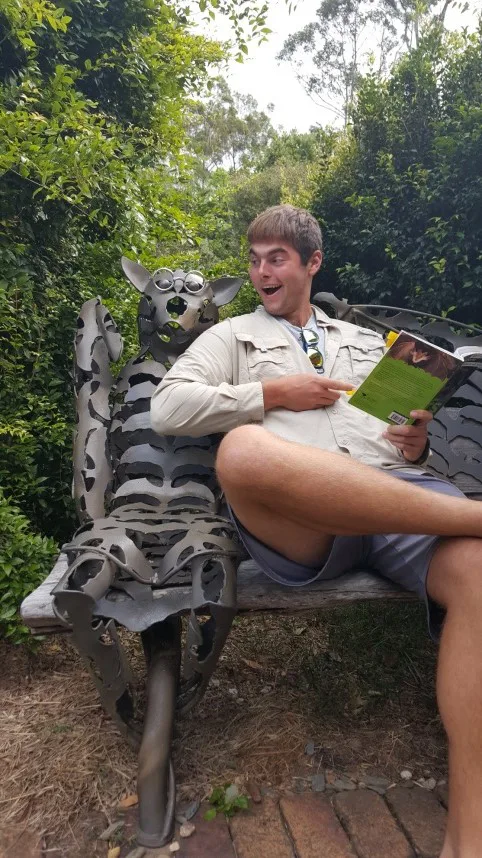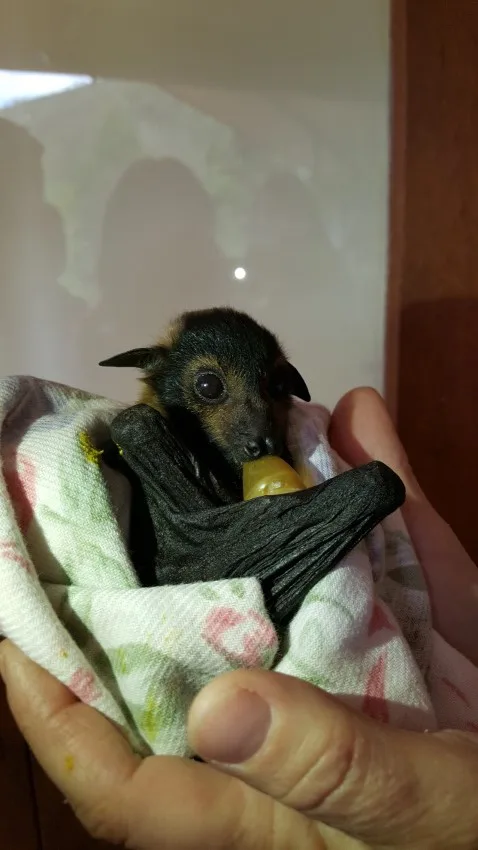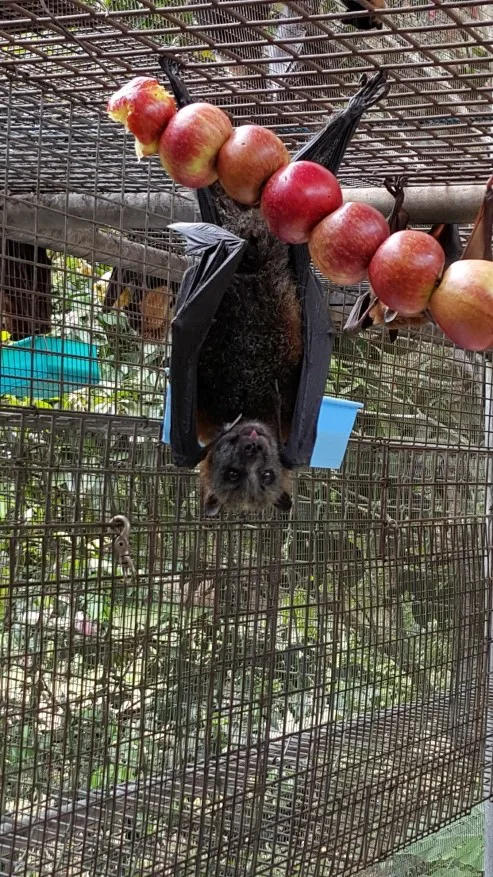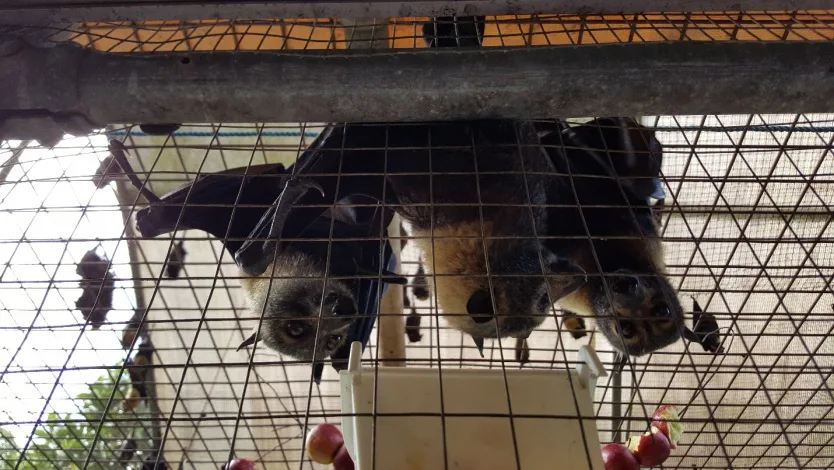
By: Georgina Lloyd, PhD
Tolga Bat Hospital
Visiting the Tolga Bat Hospital was easily my favorite part of the semester so far. It was an eye-opening, yet humbling experience. It all started the very first week we were here, when I was talking to a woman at Trees for the Evelyn and Atherton Tablelands (TREAT) while transplanting trees. She mentioned that she volunteers at TREAT and the bat hospital. She told me about how they rehabilitate bats and give tours to teach the community about their importance. Within the hour of meeting her, I asked our Student Affairs Manager if we could go, and two weeks later it became a reality. Let’s just say I was not disappointed.

We arrived and they gave us a tour of the facility. My favorite part was definitely the megabat flight cage AKA the “bat cave”. As we walked up to the huge cage you could see and hear dozens of the bats moving around feeding and mingling with one another. The volunteers explained that one of the ways you can distinguish megabats (big, fruit bats) from microbats (smaller, bug-eating bats) is that only megabats wrap their wings around their body when hanging. It looked like they were all giving themselves a hug. Once we got closer, we were let into a small “human cage” in the middle where the volunteers prepare food and do bat treatments. Inside that cage was the same woman that I had met at TREAT! It was great to see her again, and she had an abundant amount of knowledge to shed on the bats.
They had four species of megabats in the cage; the spectacled, grey-headed, black, and little red flying foxes. Watching them was very amusing. They eat with their tongue out and it’s just the funniest thing ever. I have a video of a grey chewing an apple for 45 seconds on my phone that I will cherish for the rest of my life. There was also a little red named Victor that was very interested in us, posing for pictures and everything. He’s got a future in bat modeling if you ask me.

Also, educational moment: did you know that megabats turn upside down to defecate? It’s actually really interesting. In order to prevent getting any on themselves they hang “right side up” using the hooks on their hands and then do their business, even if they have a baby attached to them. There were two mothers with babies in the cage when we were there. It was kind of hard to recognize at first, just a bulge under their wings, but when they move their wings it’s easy to see the little guy hanging on. My friend from TREAT said they hang on for up to five months after being born, living off their mother’s milk. This is incredible considering during these months the mother continues to fly around feeding with the colony. Can you imagine being born one morning and having to hang on as your mother flew around that night?!
The most eye-opening part for me was when we went into the bat hospital nursery. There was a small room with incubators full of baby bats. Most notably was Esmerelda, a spectacled flying fox only 5 days old.

She was saved when they performed a C-section on her mother who had been caught on a barbed wire fence. Unfortunately her mother did not survive, but it’s amazing that they were able to save Esmerelda. Walking through the hospital it became very apparent how negatively human beings have impacted the bats in Queensland. The volunteers said that they get hundreds of bats every week found caught on barbed wire fences. Unfortunately many of these bats have injuries so bad that they have to be put down. I found that very hard to hear. It’s astonishing how destructive, but also compassionate, human beings can be to the wildlife on our planet. Main case and point is the Tolga Bat Hospital. The woman that operates it said she started with two bat orphans over forty years ago, and now she saves and rehabilitates thousands of bats every year. Her and the many volunteers at the Tolga Bat Hospital are living proof that one person can make a difference.
There is a particularly threatening tick called the paralysis tick that can latch onto the bats feeding at lower levels of the forest and can paralyze them. If not removed, the tick can even be fatal. The volunteers at the hospital go out every day during tick season, removing ticks and rehabilitating the bats harmed by it. The worst part is that tick season lines up with the bat’s natural mating season, so often the fallen bats can be mothers with babies. It was very heart-warming to see people that were putting in so much effort into saving such a beautiful animal that goes through so much. It was humbling seeing how resilient both the bats and people of the Tolga Bat Hospital were. When I come back to Australia in the future, I have made it a goal to volunteer there and help in whatever way I can to provide a better life for some of the amazing creatures of Australia.
At the very end of our visit, I was standing next to one of the cages containing dozens of recuperating bats. There was a bat right next to the window that was extremely playful. It was looking at me, moving around, eating some apple, drinking some water, and then it opened its wing. Almost half of the membrane on its left wing was missing and it had burn marks on its torso. Then one of the caretakers came by. She said it had gotten caught on a barbed-wire fence with a “heat wire”, an electrical wire in the middle. They found him almost lifeless, dehydrated, and completely tangled in a barb hanging centimeters from the electrical wire. Any move he made sent him into the wire, causing the burns. I can’t even imagine how much pain he had been through. What was remarkable to me was that despite everything, he was recovering and seemed happier than ever. Despite his physical injuries, it looked as though nothing had ever happened to the little guy. I have never been inspired by or respected anything more in my entire life. That bat touched my heart in a way I never thought possible. As I said before, I can’t wait to come back.


Related Posts

Camila Rojas: Alumni Spotlight⭐

